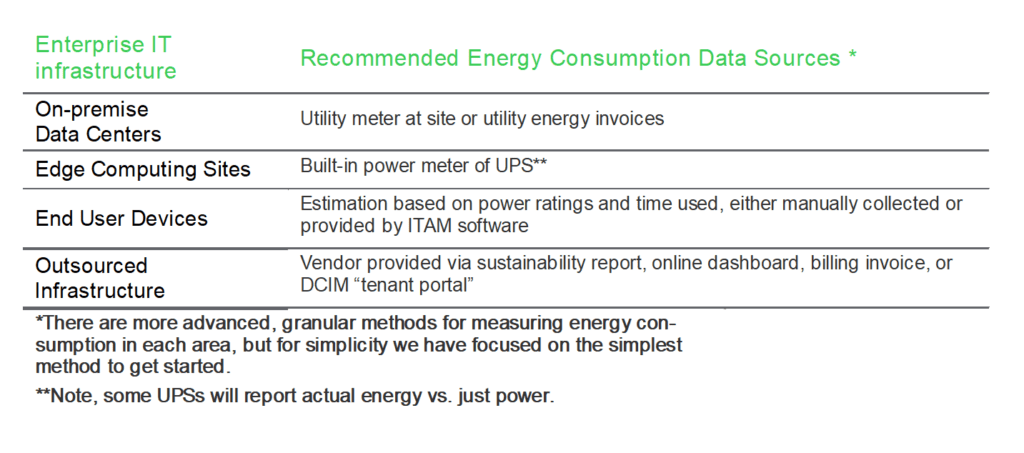Measuring, reporting, and managing a company’s sustainability performance is starting to drive employee retention, boost corporate reputation, and contribute to business success. Chief Sustainability Officers (CSOs) will report environmental sustainability metrics for the entire enterprise. However, to track progress against the enterprise’s goals and determine where inefficiencies are and improvements can be made, CSOs will need each department or function in the organization to provide more granularity in their measurement of sustainability metrics. IT is one important department where there is plenty of interest in understanding energy consumption and, ultimately, its greenhouse gas (GHG) emissions.
A recent Wall Street Journal article by Isabelle Bousquette, “CIOs Confront Sustainability Mandates: Tech leaders feeling board pressure to monitor, improve IT energy usage. The complexity can be daunting,” paints an accurate picture of CIOs stressed about how to begin their sustainability journey as pressure mounts to show progress. In the article, Penelope Prett, Chief Information, Data, and Analytics Officer at Accenture PLC stated, “That’s been the single biggest challenge for us is figuring out what we want to measure, where we’re going to get that data, [and] how we’re going to structure that data.” This fundamental challenge is what prevents many CIOs and IT operations teams from even starting to implement a sustainability plan.
We recommend that CIOs who are beginning to track sustainability start with measuring just one metric: total energy consumption. This fundamental metric shows the direct impact of IT operations and CSOs use it to calculate GHG emissions. Energy consumption is also good to start with because the data sources and collection tools are readily available, and in many cases, your IT operations team is already using them.
Schneider Electric White Paper 100, “3 Steps to Calculate Total Enterprise IT Energy Consumption Using DCIM” provides a very simple framework to measure and track IT energy consumption across the entire enterprise IT portfolio. The three steps are:
Step 1: Assess the coverage of your IT estate.
Step 2: Determine metric data sources and deploy metering and software.
Step 3: Use data center infrastructure management (DCIM) to aggregate data and report total energy consumption.

Step 1: Assess the coverage of your IT estate
This step is about ensuring you’re accounting for everything that consumes energy across your portfolio of sites and that you understand where sustainability gaps exist. Having as full of an accounting as possible ensures the metric is meaningful and represents reality. Make sure you’re including not only enterprise-owned data centers and distributed IT sites, but outsourced infrastructure (i.e., cloud and colo), as well as all end user devices. Accounting for energy consumption for outsourced infrastructure tends to be simple as the vendor typically provides that information through a report or online dashboard of some sort.
For enterprise-owned infrastructure, however, you need to assess whether power meters are in place and software management tools are in use. Power meters and management software give visibility to on-premise data center and distributed IT site and device energy consumption. End user device energy consumption, on the other hand, would be derived from data in the ITAM tool.
Step 2: Determine metric data sources and deploy metering and software
The next step is to identify your sources of energy data across your entire estate and make sure that data is being reported to management software or, in the case of end user devices, is available in your ITAM tools. Gaps in visibility identified in Step 1 should be filled by deploying power metering and/or management software where needed.
Our recommended data sources for energy consumption across your enterprise IT estate are summarized in Table 1.

Step 3: Use DCIM to aggregate data and report total energy consumption
We believe modern DCIM tools are best positioned to provide CIOs and their IT operations teams with environmental sustainability metric tracking and reporting as they are beginning to address these needs out of the box. Modern DCIM offers can aggregate data and report PUE, total energy consumption with breakdowns by subsystem, and even GHG emissions.
The ease of data collection into one dashboard depends on the specific attributes of the software tool used and the capabilities of the vendor. Some more traditional DCIM tools, for example, are architected for single sites, lacking the out-of-box ability to give an aggregate view of resources and status across multiple, distributed sites.
For environmental metrics to be meaningful, as said before, it is important the software tool used to aggregate all the data can communicate with and normalize data from all data sources. This step ensures a more complete picture of environmental impact. Software system attributes that help make this easier to accomplish include:
- Being designed for multi-site portfolios with one login providing view to all sites’ data at a site-by-site level or in aggregate.
- Supporting standard, open communications protocols (e.g., SNMP, BACnet, Modbus, etc.).
- Providing APIs/web services for data sharing and integration with other third-party software tools, devices, databases, and files.
- Offering customizable dashboards and reporting that accommodates data sources from outside the software tool providing the dashboard.
Note, some vendors offer engineering services to customize the output of a DCIM system and/or integrate the DCIM software with other data sources (e.g., emissions factor libraries) or platforms (e.g., environmental sustainability management, IT asset management software) to further address environmental sustainability and other reporting needs.
This reporting gives CIOs and their operations teams an ideal starting point to track and report the impact of their IT estate on environmental sustainability. It will raise awareness, provide a basis for setting goals, and identify opportunities to enrich the measurement data in line with the CSO’s priorities. Benchmarking becomes possible to help the organization know where to improve, what to prioritize, and how to show progress year over year.
To learn more details on how to track total energy consumption across your entire enterprise IT estate, read Schneider Electric White Paper 100, “3 Steps to Calculate Total Enterprise IT Energy Consumption Using DCIM”.



